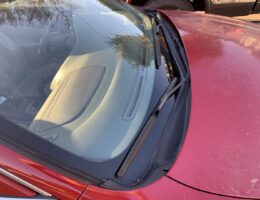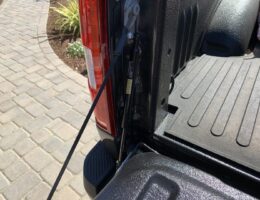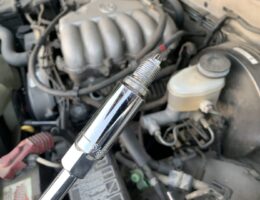As I continue to slowly do work on my 2003 Acura CL-S to get it back in proper shape, I had to address one of the issues that I experience every time I take the car out for a drive to keep the battery from dying. And that’s a simple one: the windshield wiper blades. The original wiper blades that came with the car have fallen apart and the rubber portion was barely hanging on by a thread. Every time I turned on the wiper blades, I’d hear screeching as the metal parts of the wiper arm scratched against the windshield. Although this is an easy fix, it’s a very effective one and is a good reminder to regularly change out the wiper blades on your car.
Changing the oil on a car can vary in difficulty depending on the vehicle you’re working on. Unfortunately on a 1st generation Toyota Tacoma with the 5VZ-FE (3.4L V6) engine, it is more on the difficult side mainly due to access issues with the oil filter. The draining and refilling of the oil on this vehicle is pretty straightforward, but the accessing, removing, and draining of the oil filter can be frustrating.
To properly and completely drain and fill the the coolant on our 1st generation Toyota Tacoma, it is necessary to replace the coolant in both the radiator and the engine. This requires emptying out the coolant in two locations and refilling accordingly. The 1st generation Tacoma has a variety of configurations that can make the coolant capacity slightly differ from one model to the next.
If you own a 13th generation Ford F-150 in a Lariat trim or higher, then you are blessed with the soft open of the tailgate due to it being outfitted with an OEM tailgate assist. Unfortunately if you own an XLT trim or lower trim like me, then you are met with a loud and sudden drop of the tailgate when you open it. If you prefer the soft opening of an assisted tailgate, then you have a couple of options: install a Ford OEM tailgate assist or install an aftermarket one. Since there were a high number of excellent reviews on the DeeZee tailgate assist, I decided to go this route. The install is fairly easy and doesn’t look bad.
Not all 1st generation Toyota Tacomas (1995-2004) have keyless entry. For model years 2001-2004, a factory alarm or keyless entry may be equipped with the vehicle. In these cases, a keyless entry remote should be included with the vehicle. If you purchase a new OEM remote and have a dealership program it for you, they might charge you over $100 to do so. Alternatively, you can purchase an OEM remote or a more affordable aftermarket remote, and program it yourself.
Lubricating the driveshaft (a.k.a. propeller shaft) is a key maintenance item on the 4th generation Toyota 4Runner that every owner should be doing. Armed with a grease gun and appropriate grease, it is easy to grease up the driveshaft and keep your driveline working properly. There is a bit of variability in information related to how often you should be greasing your driveshaft, as well as what type of grease you should be using on the various components of the propeller shafts. Once you navigate through the confusion around the the maintenance interval and the grease type, the maintenance itself is quite easy and ensures you keep your driveline in tip-top shape.
The 1st generation Toyota Tacoma with the 3.4L V6 (5VZ-FE engine) has six twin ground electrode spark plugs. Toyota recommends that these spark plugs be replaced every 30,000 miles, however there are many accounts of 5VZ-FE owners who have driven on the same set of spark plugs for double and triple that mileage. I personally wouldn’t let it go to 90,000 miles, but I also wouldn’t necessarily follow the 30k-mile change interval either. My parents’ Tacoma is about 15 years old with only 30k miles on the clock, so we decided to replace the spark plugs more so due to the age rather than the mileage interval.
The 1st generation Toyota Tacoma PreRunner has a RWD drivetrain that uses a rear differential to transfer power from the transmission to the rear wheels. As opposed to a 4WD vehicle which employs the use of a front differential, transfer case, and rear differential to transfer power to all four wheels, a PreRunner with RWD only has a rear differential to service. With regular driving, Toyota suggests inspecting the rear differential fluid every 15,000 miles. My Haynes Manual recommends to replace the differential fluid every 30,000 miles. On my parents’ Tacoma, they don’t do any towing. Their truck sits at a bit over 30k miles so I went ahead and did the first rear differential fluid change on this truck.
Inspection and replacement of the engine air filter on the 1st Gen Toyota Tacoma is probably one of the easiest jobs you’ll encounter. It literally takes 1 minute to inspect and maybe 2 minutes to replace. With that said, there’s no good reason for not following Toyota’s scheduled maintenance interval for inspecting and replacing the engine air filter.









